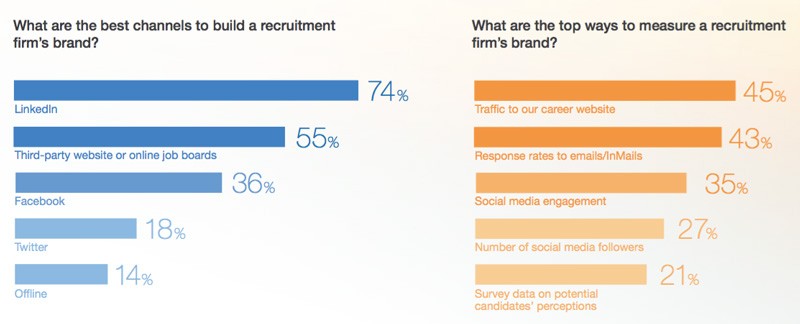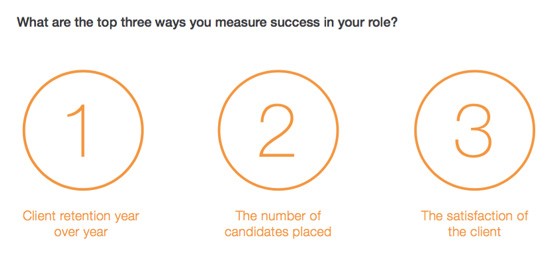3 Ways to Maximize Your Staffing Firm's Budget in 2017
According to LinkedIn’s 2017 Global Staffing Trends Report, more than half of staffing industry leaders expect their firms’ budgets to grow within the next year. Meanwhile, 79% expect the volume of candidates placed to increase, too. The result is one of the most competitive recruiting climates ever: recruiters need to focus on filling roles with quality candidates, faster. For many staffing firms, this change represents uncharted territory. How can staffing leaders stay ahead of the curve (and noise) in their industries?
To find out, we asked over 2,000 search and staffing leaders across 35 countries where they'll be investing in 2017. And, here's what they said are the top 3 areas they will focus on:
1. Branding that creates a continuous dialogue between candidates, employers, and the staffing world
Recruitment firms are known to be laser-focused with their budgets, devoting 80% of their spend to job ads, sourcing tools, and business development. This trend makes sense, given that staffing leaders are often under a time crunch to fill key roles.
As budgets start to open up, however, recruiters are looking to stand out from the crowd and build more substantive relationships with job seekers and clients. One untapped area of opportunity is branding. While 82% of staffing leaders agree that investing in a brand opens doors for more business, only 10% of recruiting budgets are currently going to branding.
What’s important to understand is that the definition of branding, itself, is evolving. Branding is no longer a one-time investment: instead, recruiters need to focus on maintaining a steady, continuous dialogue with their target customers. But few recruiters have the tools or resources to maintain a direct line of communication at scale: when staffing agencies take the time to build their personal brands, they become a magnet for their target audiences.
This gap creates an area of opportunity for recruiters to launch and promote their brands. Social media provides a direct path to generate awareness, develop a hub for open roles, and drive website traffic.
Here are 3 resources to get started:
- Why Your Staffing Firm Needs to Prioritize Branding - A checklist to help your firm get started with branding.
- 5 Marketing Tools to Help You Build a Talent Brand Strategy - A roundup of marketing resources to help you get your brand off the ground.
- 6 Steps to Building Your Recruiter Brand on LinkedIn - A guide to help empower your team of recruiters.
2. Automation of mindless processes to free recruiters to get more creative with their strategies and tactics
There simply aren’t enough hours in the day for recruiters to do everything that they have on their agendas: from reading resumes to screening candidates and building relationships with clients, staffing leaders’ schedules are slammed. Even with growing budgets, teams are still resource strapped. And here’s the kicker, according to LinkedIn’s report— competition for talent is the number one challenge firms are facing:
That means staffing firms need to free up their recruiters’ time through automation of redundant and time-consuming processes so they can stay competitive.
Given that 80% of recruiting spend goes to job ads, sourcing tools, and business development, it’s clear that staffing leaders are aware of the power of automation. But what they may not realize is how quickly technology is changing. In addition to advertising jobs, recruiters can now automate the following through pre-defined workflows and engineering best practices:
- Data-driven targeting of job ads using algorithms that match open roles to ideal candidates based on criteria that they’ve specified to be their ideal roles
- Candidate relationship management through tools that help streamline important communication touchpoints, to ensure that communication stays steady
- Candidate pre-screening and vetting based on preselected criteria
Automation enables speed while reducing human bias, freeing up recruiters’ time and attention spans to focus on more creative projects—like writing engaging status updates, for instance.
Here are 3 resources to show you how automation can save recruiters time:
- The Staffing Firm’s Guide to Modern Recruiting - Tips for navigating candidate-driven marketplaces.
- 2 New Ways to Discover Candidates Who are Open to Hearing from You on LinkedIn - A guide to reducing your time to hire while strengthening engagement with each and every candidate.
- Robots and Recruiters: What the Future Could Hold - A glimpse into what the future of automation could look like for recruiters.
3. A data-driven strategy to focus on untapped opportunities and growth
With staffing agencies needing to reach candidates and clients quickly, data can help provide the most efficient and personalized path forward.
When focusing on both long-term strategy and short-term targeting, staffing leaders need to adopt a data-driven approach. But what are the right metrics to track?
When it comes to measuring performance, staffing firms focus on metrics that have a lasting impact on the business. That is why the relationships with their clients -- client retention and satisfaction -- are paramount for staffing firms and their ability to be seen as a long-term consultative partner. Here’s how staffing leaders are tracking success in their roles:
Not sure what metrics to tack for your business? Check out these resources from the LinkedIn Talent Blog:
- 6 Big Data Metrics that Drive Quality of Hire - A guide to measuring the efficiency of your recruiting operations, and build deeper relationships with top candidates along the way.
- Data Driven Recruiting - A resource for using talent analytics to find quality hires, faster.
- 4 Pitfalls to Avoid When Managing Your Talent Brand - A guide to help you measure your recruiting firm’s talent brand efficiently and accurately.
Final thoughts
Where does your recruiting firm stand, compared to the competition in your industry? Take a look at LinkedIn’s 2017 Global Staffing Trends Report for in-depth answers that are unique to 2017.
To receive blog posts like this one straight in your inbox, subscribe to the blog newsletter.
Topics: Staffing agencies
Related articles






